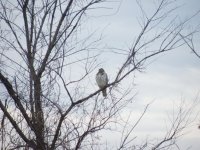P
pusser_uk
Guest
I wonder if someone can help me with this hawk. Still learning about all the birds over this side of the pond. 
I got this shot from half way down my yard. My camera was at full 18x zoom and I have had to lighten it up a bit to see some detail. I have been trying to make a positive ID using Enature.com but many of the photos there are so small as to make it difficult to be sure.
I got this shot from half way down my yard. My camera was at full 18x zoom and I have had to lighten it up a bit to see some detail. I have been trying to make a positive ID using Enature.com but many of the photos there are so small as to make it difficult to be sure.




